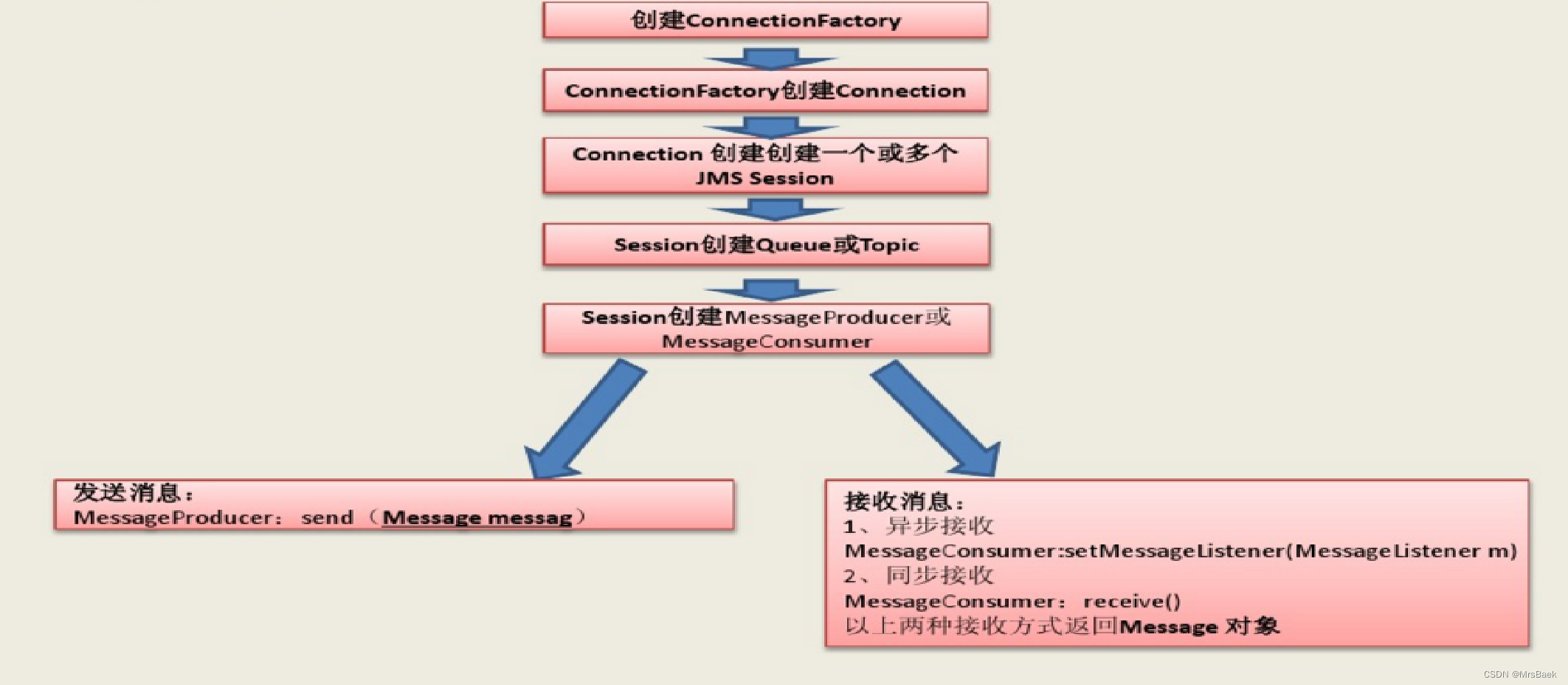消息队列是一种在不同组件或应用之间进行数据传递的技术,通常用于处理异步通信。它允许消息的发送者(生产者)和接收者(消费者)之间进行解耦。

概念
消息队列是一种先进先出(FIFO)的数据结构,它存储待处理的消息直到它们被消费。消息是生产者发送给队列的数据单元,消费者则从队列中读取这些消息进行处理。
原理
1. 生产者:
- 生产者是创建消息的实体,它负责将消息发送到队列。生产者不需要关心消息的具体处理过程,只需确保消息正确发送到队列。
2. 消息队列:
- 消息队列充当缓冲区,暂时存储从生产者那里发送过来的消息。队列管理消息的顺序,并确保按照发送的顺序逐一传递给消费者。
3. 消费者:
- 消费者从消息队列中读取消息,并进行相应的处理。消费者可以是同一应用的其他部分,或者是完全独立的应用。
4. 消息处理:
- 一旦消息被消费者读取,它可以被确认和删除,或者在处理失败时重新放回队列等待再次处理。
使用场景
异步处理:当应用执行耗时任务时,可以将任务封装成消息发送到队列,由消费者异步处理。
流量控制:在高流量事件如大促销或黑色星期五时,消息队列可以帮助缓冲入站流量,防止系统过载。
解耦服务:在微服务架构中,消息队列可以帮助减少服务之间的直接依赖,通过消息传递来通信,从而提高系统的可维护性和扩展性。
Java消息队列技术
在Java中,消息队列是一种数据结构或服务,用于在不同的应用组件或系统之间异步传递消息。它支持松耦合的架构,允许发送者和接收者独立地进行开发和扩展。消息队列可以帮助缓解高负载、增强系统的可伸缩性,并提供容错机制。下面是一些常见的Java消息队列技术:
1. Apache Kafka:
Kafka是一个分布式流处理平台,它不仅能够处理消息队列的功能,还能处理复杂的事件流。它特别适合需要高吞吐量和可靠性的大规模数据处理场景。
2. RabbitMQ:
RabbitMQ是一个开源消息代理,支持多种消息协议。它提供灵活的路由功能,能够保证消息的可靠传输。适合于复杂的消息传递需求和多种不同的通信模式。
3. ActiveMQ:
Apache ActiveMQ是一个强大的开源消息代理,支持多种JMS(Java Message Service)协议和客户端语言。适用于那些需要JMS标准支持的企业应用。
4. Amazon SQS (Simple Queue Service):
SQS是一个托管的消息队列服务,提供简单的Web服务API来完全管理队列的消息传输。它能够无限扩展,并且不需要预先安装消息队列基础设施。
5. Google Cloud Pub/Sub:
Google的Pub/Sub提供了一种全球分布式的消息传递平台,适合处理大量数据的实时交换。

这个流程图展示了使用 ActiveMQ 实现消息队列的基本步骤,包括消息的发送和接收。以下是每个步骤的详细讲解。
1. 创建 ConnectionFactory
`ConnectionFactory` 是一个接口,用于创建连接到消息中间件(ActiveMQ)的工厂。它是创建连接的起点。
ConnectionFactory connectionFactory = new ActiveMQConnectionFactory("tcp://localhost:61616");
2. 使用 ConnectionFactory 创建 Connection
通过 `ConnectionFactory` 创建一个连接对象 `Connection`。
Connection connection = connectionFactory.createConnection();3. 启动 Connection
在使用连接之前,必须启动它。
connection.start();4. 使用 Connection 创建一个或多个 JMS Session
通过 `Connection` 创建会话 `Session`。会话是生产和消费消息的上下文。
Session session = connection.createSession(false, Session.AUTO_ACKNOWLEDGE);
5. 使用 Session 创建 Queue 或 Topic
通过会话创建队列(Queue)或主题(Topic)。队列用于点对点消息传递,主题用于发布/订阅消息传递。
Queue queue = session.createQueue("testQueue");
// 或者
Topic topic = session.createTopic("testTopic");6. 使用 Session 创建 MessageProducer 或 MessageConsumer
根据需要创建消息生产者 `MessageProducer` 或消息消费者 `MessageConsumer`。
创建 MessageProducer
MessageProducer producer = session.createProducer(queue);创建 MessageConsumer
MessageConsumer consumer = session.createConsumer(queue);
7. 发送消息
使用 `MessageProducer` 发送消息。
TextMessage message = session.createTextMessage("Hello, ActiveMQ!");
producer.send(message);8. 接收消息
异步接收
设置消息监听器,当有消息到达时自动触发。
consumer.setMessageListener(new MessageListener() {@Overridepublic void onMessage(Message message) {if (message instanceof TextMessage) {try {String text = ((TextMessage) message).getText();System.out.println("Received: " + text);} catch (JMSException e) {e.printStackTrace();}}}
});同步接收
使用 `MessageConsumer.receive()` 方法同步接收消息。
Message message = consumer.receive();
if (message instanceof TextMessage) {String text = ((TextMessage) message).getText();System.out.println("Received: " + text);
}完整代码示例
生产者代码
import org.apache.activemq.ActiveMQConnectionFactory;import javax.jms.*;public class Producer {public static void main(String[] args) throws JMSException {// 创建连接工厂ConnectionFactory connectionFactory = new ActiveMQConnectionFactory("tcp://localhost:61616");// 创建连接Connection connection = connectionFactory.createConnection();connection.start();// 创建会话Session session = connection.createSession(false, Session.AUTO_ACKNOWLEDGE);// 创建队列Queue queue = session.createQueue("testQueue");// 创建生产者MessageProducer producer = session.createProducer(queue);// 创建消息TextMessage message = session.createTextMessage("Hello, ActiveMQ!");// 发送消息producer.send(message);// 关闭连接connection.close();}
}消费者代码
import org.apache.activemq.ActiveMQConnectionFactory;import javax.jms.*;public class Consumer {public static void main(String[] args) throws JMSException {// 创建连接工厂ConnectionFactory connectionFactory = new ActiveMQConnectionFactory("tcp://localhost:61616");// 创建连接Connection connection = connectionFactory.createConnection();connection.start();// 创建会话Session session = connection.createSession(false, Session.AUTO_ACKNOWLEDGE);// 创建队列Queue queue = session.createQueue("testQueue");// 创建消费者MessageConsumer consumer = session.createConsumer(queue);// 同步接收消息Message message = consumer.receive();if (message instanceof TextMessage) {String text = ((TextMessage) message).getText();System.out.println("Received: " + text);}// 异步接收消息consumer.setMessageListener(new MessageListener() {@Overridepublic void onMessage(Message message) {if (message instanceof TextMessage) {try {String text = ((TextMessage) message).getText();System.out.println("Received: " + text);} catch (JMSException e) {e.printStackTrace();}}}});// 为了测试异步接收,保持程序运行一段时间try {Thread.sleep(10000);} catch (InterruptedException e) {e.printStackTrace();}// 关闭连接connection.close();}
}具体应用
调用百度云api
使用消息队列实现一个调用百度智能云 API 的校园卡程序有助于提高系统的可扩展性和可靠性。消息队列可以解耦生产者和消费者,并实现异步处理。
实现步骤
1. 配置消息队列:
- 安装并配置 RabbitMQ 或 ActiveMQ。
- 配置 Spring Boot 项目以连接到消息队列。
2. 创建生产者(Producer):
- 接收用户上传的图片。
- 将图片编码为 Base64 格式,并发送到消息队列。
3. 创建消费者(Consumer):
- 监听消息队列中的消息。
- 调用百度智能云 API 进行图片识别。
- 将识别结果存储以便后续查询。
4. 实现控制器(Controller):
- 提供上传图片的接口。
- 提供获取识别结果的接口。
系统架构图
+-------------------+ +--------------------+ +-------------------+
| | | | | |
| User Uploads | | Message Queue | | API Consumer |
| (Controller) | -----> | (RabbitMQ/ActiveMQ)| -----> | (Baidu API Call) |
| | | | | |
+-------------------+ +--------------------+ +-------------------+具体实现
- 用户上传图片:用户通过前端页面上传图片,图片通过
RecognitionController接收并保存到消息队列。 - 消息队列:图片以消息的形式存储在消息队列中,保证消息的可靠传递。
- 消息处理:
RecognitionListener监听消息队列,当有新消息到达时,调用百度智能云 API 进行图片识别,并将结果保存到RecognitionService。 - 获取结果:用户可以通过访问
/api/resultPage来获取最新的识别结果。
代码部分:
1. 配置消息队列:
配置 `application.properties` 以连接到消息队列(以 ActiveMQ 为例):
spring.activemq.broker-url=tcp://localhost:61616spring.activemq.user=adminspring.activemq.password=adminspring.jms.pool.enabled=true2. 创建生产者(Producer):
package com.example.mq;import org.springframework.beans.factory.annotation.Autowired;import org.springframework.jms.core.JmsTemplate;import org.springframework.stereotype.Service;@Servicepublic class RecognitionService {@Autowiredprivate JmsTemplate jmsTemplate;public void sendImageForRecognition(byte[] imageBytes) {jmsTemplate.convertAndSend("animal.recognition.queue", imageBytes);}// 其他方法...}3. 创建消费者(Consumer):
package com.example.mq;import org.springframework.beans.factory.annotation.Autowired;import org.springframework.jms.annotation.JmsListener;import org.springframework.stereotype.Component;@Componentpublic class RecognitionListener {@Autowiredprivate RecognitionService recognitionService;@JmsListener(destination = "animal.recognition.queue")public void processImage(byte[] imageBytes) {String result = recognitionService.recognizeImage(imageBytes);recognitionService.saveResult(result);}}4. 实现控制器(Controller):
package com.example.mq;import org.springframework.beans.factory.annotation.Autowired;import org.springframework.stereotype.Controller;import org.springframework.ui.Model;import org.springframework.web.bind.annotation.*;import org.springframework.web.multipart.MultipartFile;import org.springframework.web.servlet.view.RedirectView;import java.io.IOException;@Controller@RequestMapping("/api")public class RecognitionController {@Autowiredprivate RecognitionService recognitionService;@PostMapping("/recognize")public RedirectView recognizeAnimal(@RequestParam("file") MultipartFile file, Model model) throws IOException {if (file.isEmpty()) {model.addAttribute("message", "File is empty");return new RedirectView("/errorPage.html");}byte[] bytes = file.getBytes();recognitionService.saveResult("等待识别结果...");recognitionService.sendImageForRecognition(bytes);return new RedirectView("/resultPage.html");}@GetMapping("/resultPage")@ResponseBodypublic String getResult() {return recognitionService.getResult();}}消息队列的意义
异步处理:允许用户在上传图片后立即获得响应,而不是等待图片识别结果。
解耦:上传图片的部分和图片识别的部分可以独立开发和扩展。
负载均衡:可以轻松增加更多的消费者以处理高并发请求。
可靠性:消息队列持久化消息,确保即使在系统故障时也不会丢失消息。


】Nios® II无法使用基于 Ubuntu 18.04.5 的 WSL 进行构建)
--无监督学习(一)聚类)

)


:时间管理、消息队列、信号量、任务内嵌信号量/队列、事件标志、软件定时器、内存管理)






)


)
?以实际例子理解看涨期权(Call)和看跌期权(Put))